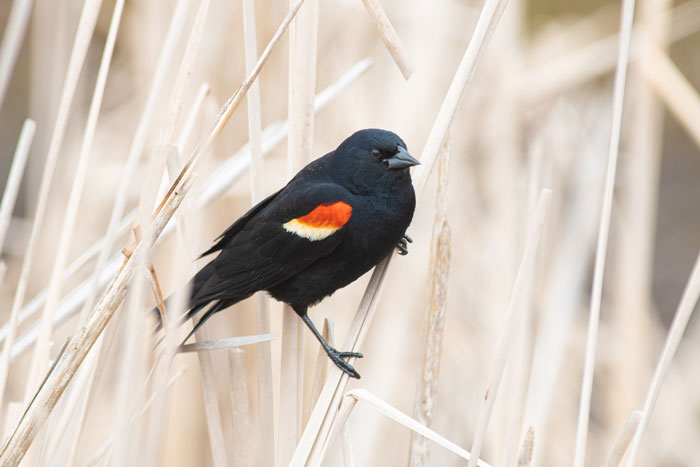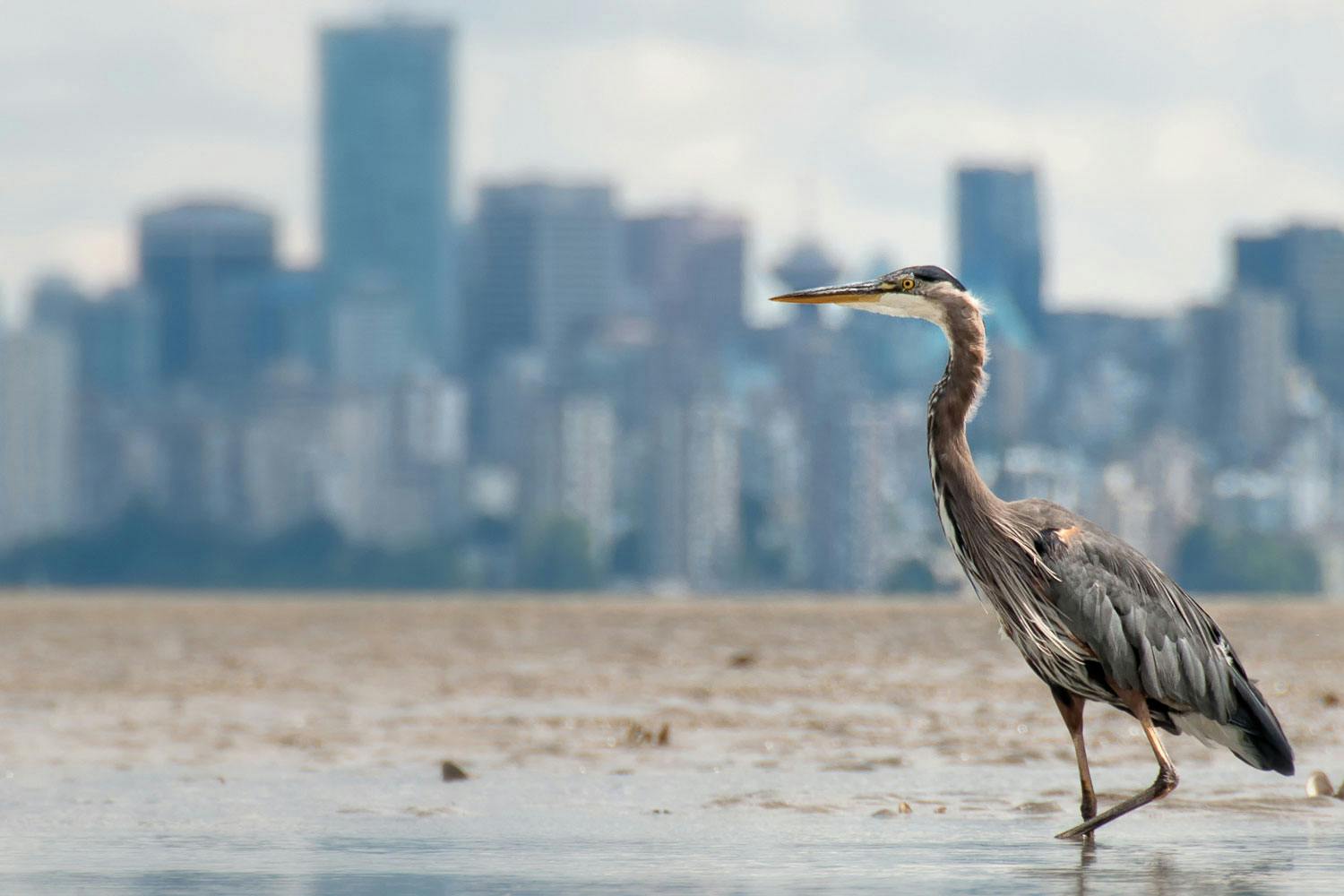Making Cities Safe for Birds
Urban areas can be deathtraps for birds. A new certification aims to make them havens.
The Bird Friendly City certification program recognizes municipalities taking action to protect birds. More than 30 cities are working towards certification.
When you think of bird habitat, what comes to mind? Perhaps a wetland teeming with waterfowl, or a woodland resounding with birdsong. But what about a city? Urban areas are home to a variety of species, from the finches at your feeder to the hawks circling overhead. In fact, 20% of the world’s bird species occur in cities.
“Nature doesn’t just exist far out in the pristine, untouched landscapes,” says Aly Hyder Ali, an urban nature organizer with Nature Canada, a national conservation charity. “We have nature within our communities.”
20% of the world’s bird species occur in cities.
Cities also contain some of the biggest threats to birds. Cats top the list, killing between 100 and 350 million birds every year in Canada alone. Buildings are almost as deadly; in Canada window collisions kill up to 42 million birds a year. Even if birds dodge deadly glass towers and escape the jaws of a cat, they still have to find habitat — which is hard to come by the more we cut it down and pave it over.
Unsurprisingly, bird populations have taken a nosedive. Scientists estimate that North America has lost nearly 3 billion birds since 1970. That’s 29% of the continent’s birds gone, forever. These aren’t just rare and threatened species — they include birds considered common and widespread. If we are to save birds, we need to make cities friendlier places for them.
What is a bird-friendly city?
The Bird Friendly City certification program was developed by Nature Canada to recognize municipalities taking action to protect birds. The first four cities were awarded in May 2021: Toronto, Calgary, Vancouver, and London, ON. Currently, more than 30 cities are working towards certification.
“We developed the certification standard with the lens that we wanted to address all of the main threats and concerns that bird populations face within our municipalities,” says Hyder Ali, who runs the program.
The first step to certification is establishing a “bird team,” which meets at least quarterly and includes a liaison with the municipality. “There is no minimum number of members for bird teams,” says Hyder Ali, “But we do recommend bird teams have a group of individuals and organizations with diverse sets of skills, perspectives, and experiences.”
North America has lost nearly 3 billion birds since 1970. That’s 29% of the continent’s birds gone, forever.
For example, the Calgary bird team’s 14 members represent organizations like the Calgary BiodiverCity Advisory Committee, the Royal Astronomical Society of Canada, and Mount Royal University.
Bird teams should include members of the local Indigenous community; if they don’t, the municipality must provide written correspondence proving their outreach efforts. Applicants must also recognize the Indigenous territory on which the municipality lies, both at bird team meetings and on the application.
Once these criteria are met, a city can earn up to 50 points through actions that address threat reduction, habitat, and public education. Nature Canada evaluates each application and adds up all of the points to determine a final score. A score of 48% equals entry-level certification, 64% is intermediate, and 80% is high.
Threat reduction
Studies have shown that even well-fed pet cats hunt birds when given the chance. To prevent birds from falling prey to cats, Nature Canada awards points for no-roaming by-laws, which require cats to be kept indoors or walked on a leash. London’s Animal Control By-law, for example, prohibits cats from roaming at large and requires pet cats to be licensed. The city also runs a trap-neuter-return program to humanely reduce feral cat populations.
Nature Canada also encourages cities to adopt bird-friendly building standards to prevent window strikes. Birds fly into windows because they can’t differentiate reflections from the real world, so windows can be made safer by using bird-deterrent markers or film to break up reflections. It’s a strategy that proved effective for the Vancouver park board office, which was once the site of numerous collisions. After Feather Friendly markers were installed, the collisions were virtually eliminated.

“We have a responsibility, not only to ourselves, not only to our descendants, not only to our communities, but also for nature itself, to ensure the protection of that nature within our communities,” says Hyder Ali.
Toronto was the first city in North America to publish bird-friendly development guidelines for new and existing buildings. Introduced in 2007, these guidelines have since been incorporated into the Toronto Green Standard, which is required for new developments. Vancouver introduced voluntary bird-friendly design standards in 2015.
Cities can also be made safer by turning off building lights at night. Many birds migrate at night, when the air is cooler and fewer predators are about. They navigate by the moon and stars, so city lights can lure them into the urban environment. Toronto’s Lights Out campaign asks people to turn out unnecessary lights at work and at home.
Cities can score additional points for banning non-essential herbicides and insecticides, which can be lethal to birds. They are also encouraged to reduce the amount of plastic pollution, which can either entangle birds or be ingested by them.
Habitat protection, restoration, and climate resiliency
Whether birds nest, overwinter, or migrate through cities, they need habitat. Nature Canada encourages expanding and connecting protected areas, planting neighbourhood trees, and gardening with native plants. Bird-friendly cities should also limit vegetation management (like tree pruning or mowing) during the spring-summer nesting season. (Depending on where you live, birds begin nesting as early as late March and continue through late August.)
The City of Vancouver introduced the Vancouver Bird Strategy in 2015 to “create the conditions for native birds to thrive in Vancouver and across the region.” Stanley Park, for example, is managed jointly by the park board and the Stanley Park Ecology Society to protect important bird habitat. Activities include eagle nest monitoring, heron colony management and monitoring, and Canada goose management.
It takes a lot of work to create a bird-friendly city, and it doesn’t happen overnight — but it’s worth it.
Cities are also encouraged to support species of concern by protecting breeding or stopover habitat. This is critical for birds that rely on human-built structures, like the threatened chimney swift — an aerial insectivore that nests in chimneys. A single chimney can house thousands of swifts during migration, when the birds roost communally.
A healthy habitat is more resilient — and can mitigate the impacts of climate change — so Nature Canada recommends nature-based climate adaptation strategies, like wetland creation to absorb and retain flood water.
Community outreach and education
A bird-friendly city is a place to enjoy and learn about birds. Infrastructure like observation towers and trails should be easy to find and access by sustainable transportation. The City of Calgary, for example, has extensive trail networks and a wealth of bird sanctuaries accessible by pedestrian and cycling trails.
Education can take various forms. School boards can include bird-related curriculum, and colleges and universities can organize habitat creation projects and undertake bird research. Municipalities, conservation authorities, or nature groups can offer outdoor education and run citizen science programs like bird surveys.
Finally, a bird-friendly city celebrates birds. All certified cities organize events for World Migratory Bird Day in May. Toronto and Vancouver have expanded the celebration to a week-long festival, with free workshops, expeditions, talks, and exhibitions.
Cities can get even friendlier
Hyder Ali says all of the certified cities are working to earn more points for their next annual review. And that’s the idea — to get municipalities started and keep working up the ladder. He says it takes a lot of work to create a bird-friendly city, and it doesn’t happen overnight — but it’s worth it.
“We have a responsibility, not only to ourselves, not only to our descendants, not only to our communities, but also for nature itself, to ensure the protection of that nature within our communities,” he says. “Birds have a right to live; they have a right to thrive, just as much as we do.”
Print Issue: Spring 2022
Print Title: For the Birds
